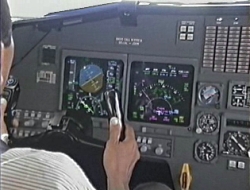CLICK ON IMAGE FOR ENLARGEMENT VIEW
FACTUAL INFORMATION
HISTORY OF FLIGHT
On March 10, 2019, at about 05:44 UTC1, Ethiopian Airlines flight 302, a Boeing 737-8 (MAX), Ethiopian registration ET-AVJ, crashed near Ejere, Ethiopia, shortly after takeoff from Addis Ababa Bole International Airport (HAAB), Ethiopia. The flight was a regularly scheduled international passenger flight from Addis Ababa to Jomo Kenyatta International Airport (HKJK), Nairobi, Kenya. There were 157 passengers and crew on board. All were fatally injured, and the Aircraft was destroyed.
The following is based on the preliminary analysis of the DFDR, CVR and ATC communications. As the investigation continues, revisions and changes may occur before the final report is published.
At 05:37:34, ATC issued take off clearance to ET-302 and to contact radar on 119.7 MHz.
Takeoff roll began from runway 07R at a field elevation of 2333.5 m at approximately 05:38, with a flap setting of 5 degrees and a stabilizer setting of 5.6 units. The takeoff roll appeared normal, including normal values of left and right angle-of-attack (AOA). During takeoff roll, the engines stabilized at about 94% N1, which matched the N1 Reference recorded on the DFDR. From this point for most of the flight, the N1 Reference remained about 94% and the throttles did not move. The N1 target indicated non data pattern 220 seconds before the end of recording. According to the CVR data and the control column forces recorded in DFDR, captain was the pilot flying.
At 05:38:44, shortly after liftoff, the left and right recorded AOA values deviated. Left AOA decreased to 11.1° then increased to 35.7° while value of right AOA indicated 14.94°. Then after, the left AOA value reached 74.5° in ¾ seconds while the right AOA reached a maximum value of 15.3°. At this time, the left stick shaker activated and remained active until near the end of the recording. Also, the airspeed, altitude and flight director pitch bar values from the left side noted deviating from the corresponding right side values. The left side values were lower than the right side values until near the end of the recording.
At 05:38:43 and about 50 ft radio altitude, the flight director roll mode changed to LNAV.
At 05:38:46 and about 200 ft radio altitude, the Master Caution parameter changed state. The First Officer called out Master Caution Anti-Ice on CVR. Four seconds later, the recorded Left AOA Heat parameter changed state.
At 05:38:58 and about 400 ft radio altitude, the flight director pitch mode changed to VNAV SPEED and Captain called out “Command” (standard call out for autopilot engagement) and an autopilot warning is recorded.
At 05:39:00, Captain called out “Command”.
At 05:39:01 and about 630 ft radio altitude, a second autopilot warning is recorded.
At 05:39:06, the Captain advised the First-Officer to contact radar and First Officer reported SHALA 2A departure crossing 8400 ft and climbing FL 320.
Between liftoff and 1000 ft above ground level (AGL), the pitch trim position moved between 4.9 and 5.9 units in response to manual electric trim inputs. At 1000 ft AGL, the pitch trim position was at 5.6 units.
At 05:39:22 and about 1,000 feet the left autopilot (AP) was engaged (it disengaged about 33 seconds later), the flaps were retracted and the pitch trim position decreased to 4.6 units.
Six seconds after the autopilot engagement, there were small amplitude roll oscillations accompanied by lateral acceleration, rudder oscillations and slight heading changes. These oscillations continued also after the autopilot was disengaged.
At 05:39:29, radar controller identified ET-302 and instructed to climb FL 340 and when able right turns direct to RUDOL and the First-Officer acknowledged.
At 05:39:42, Level Change mode was engaged. The selected altitude was 32000 ft. Shortly after the mode change, the selected airspeed was set to 238 kt.
At 05:39:45, Captain requested flaps up and First-Officer acknowledged. One second later, flap handle moved from 5 to 0 degrees and flaps retraction began.
At 05:39:50, the selected heading started to change from 072 to 197 degrees and at the same time the Captain asked the First-Officer to request to maintain runway heading.
At 05:39:55, Autopilot disengaged,
At 05:39:57, the Captain advised again the First-Officer to request to maintain runway heading and that they are having flight control problems.
At 05:40:00 shortly after the autopilot disengaged, the FDR recorded an automatic aircraft nose down (AND) activated for 9.0 seconds and pitch trim moved from 4.60 to 2.1 units. The climb was arrested and the aircraft descended slightly.
At 05:40:03 Ground Proximity Warning System (GPWS) “DON’T SINK” alerts occurred.
At 05:40:05, the First-Officer reported to ATC that they were unable to maintain SHALA 1A and requested runway heading which was approved by ATC.
At 05:40:06, left and right flap position reached a recorded value of 0.019 degrees which remained until the end of the recording.
The column moved aft and a positive climb was re-established during the automatic AND motion.
At 05:40:12, approximately three seconds after AND stabilizer motion ends, electric trim (from pilot activated switches on the yoke) in the Aircraft nose up (ANU) direction is recorded on the DFDR and the stabilizer moved in the ANU direction to 2.4 units. The Aircraft pitch attitude remained about the same as the back pressure on the column increased.
At 05:40:20, approximately five seconds after the end of the ANU stabilizer motion, a second instance of automatic AND stabilizer trim occurred and the stabilizer moved down and reached 0.4 units.
From 05:40:23 to 05:40:31, three Ground Proximity Warning System (GPWS) “DON’T SINK” alerts occurred.
At 05:40:27, the Captain advised the First-Officer to trim up with him.
At 05:40:28 Manual electric trim in the ANU direction was recorded and the stabilizer reversed moving in the ANU direction and then the trim reached 2.3 units.
At 05:40:35, the First-Officer called out “stab trim cut-out” two times. Captain agreed and FirstOfficer confirmed stab trim cut-out.
At 05:40:41, approximately five seconds after the end of the ANU stabilizer motion, a third instance of AND automatic trim command occurred without any corresponding motion of the stabilizer, which is consistent with the stabilizer trim cutout switches were in the ‘’cutout’’ position
At 05:40:44, the Captain called out three times “Pull-up” and the First-Officer acknowledged.
At 05:40:50, the Captain instructed the First Officer to advise ATC that they would like to maintain 14,000 ft and they have flight control problem.
At 05:40:56, the First-Officer requested ATC to maintain 14,000 ft and reported that they are having flight control problem. ATC approved.
From 05:40:42 to 05:43:11 (about two and a half minutes), the stabilizer position gradually moved in the AND direction from 2.3 units to 2.1 units. During this time, aft force was applied to the control columns which remained aft of neutral position. The left indicated airspeed increased from approximately 305 kt to approximately 340 kt (VMO). The right indicated airspeed was approximately 20-25 kt higher than the left.
The data indicates that aft force was applied to both columns simultaneously several times throughout the remainder of the recording.
At 05:41:20, the right overspeed clacker was recorded on CVR. It remained active until the end of the recording.
At 05:41:21, the selected altitude was changed from 32000 ft to 14000 ft.
At 05:41:30, the Captain requested the First-Officer to pitch up with him and the First-Officer acknowledged.
At 05:41:32, the left overspeed warning activated and was active intermittently until the end of the recording.
At 05:41:46, the Captain asked the First-Officer if the trim is functional. The First-Officer has replied that the trim was not working and asked if he could try it manually. The Captain told him to try. At 05:41:54, the First-Officer replied that it is not working.
At 05:42:10, the Captain asked and the First-Officer requested radar control a vector to return and ATC approved.
At 05:42:30, ATC instructed ET-302 to turn right heading 260 degrees and the First-Officer acknowledged.
At 05:42:43, the selected heading was changed to 262 degrees.
At 05:42:51, the First-Officer mentioned Master Caution Anti-Ice. The Master Caution is recorded on DFDR.
At 05:42:54, both pilots called out “left alpha vane”.
At 05:43:04, the Captain asked the First Officer to pitch up together and said that pitch is not enough.
At 05:43:11, about 32 seconds before the end of the recording, at approximately 13,4002 ft, two momentary manual electric trim inputs are recorded in the ANU direction. The stabilizer moved in the ANU direction from 2.1 units to 2.3 units.
At 05:43:20, approximately five seconds after the last manual electric trim input, an AND automatic trim command occurred and the stabilizer moved in the AND direction from 2.3 to 1.0 unit in approximately 5 seconds. The aircraft began pitching nose down. Additional simultaneous aft column force was applied, but the nose down pitch continues, eventually reaching 40° nose down. The stabilizer position varied between 1.1 and 0.8 units for the remainder of the recording.
The left Indicated Airspeed increased, eventually reaching approximately 458 kts and the right Indicated Airspeed reached 500 kts at the end of the recording. The last recorded pressure altitude was 5,419 ft on the left and 8,399 ft on the right.

















